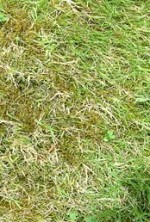 Most lawns will have a moss problem at some time. The growth of moss is a sign that growing conditions are not favorable for grass; the moss moves into the lawn where the grass is sparse and struggling. It does not crowd out the grass or kill it. When you see moss in the lawn you should thank it for showing you that your lawn needs help and then evaluate your lawn with the intention of improving it, not just killing the moss.
Most lawns will have a moss problem at some time. The growth of moss is a sign that growing conditions are not favorable for grass; the moss moves into the lawn where the grass is sparse and struggling. It does not crowd out the grass or kill it. When you see moss in the lawn you should thank it for showing you that your lawn needs help and then evaluate your lawn with the intention of improving it, not just killing the moss.
Look at the areas where moss is present and consider the possible causes:
Low Soil Fertility-grasses like a large supply of nutrients especially nitrogen.
Acid Soil-grasses like a pH between 6.6 and 7, that is slightly acid to neutral.
Light-grasses like full sun but some with tolerate partial shade; shrubs and trees grow so what used to be a sunny place can turn into a shady one.
Water-over watering or excessive rainfall can hurt the grass and create favorable conditions for moss growth. Drought can stress the grass and reduce its vigor.
Compact Soil-water, nutrients, and air have difficulty entering compact soil resulting in a decline in grass growth.
Mowing Practices-mowing is stressful for grass and removing more than 1/3 the height can cause damage.
Traffic-areas along driveways, paths, around patios and in children’s play area receive a lot of wear that weaken the grass.
Once you have identified the problem causing the decline of the lawn and the appearance of the moss you can tackle improvement process.
Moss Removal
 To kill the moss use a product that contains ferrous sulfate, ferrous ammonium sulfate, or copper sulfate. These products are environmentally safe but may stain concrete as well as other materials.
To kill the moss use a product that contains ferrous sulfate, ferrous ammonium sulfate, or copper sulfate. These products are environmentally safe but may stain concrete as well as other materials.
 Mechanically remove the dead and dying moss with a rake.
Mechanically remove the dead and dying moss with a rake.
 Rehabilitation of the Growing Area. Getting rid of the moss is a temporary solution to the problem. The moss will return unless the conditions that favor moss grow and discourage grass growth are changed.
Rehabilitation of the Growing Area. Getting rid of the moss is a temporary solution to the problem. The moss will return unless the conditions that favor moss grow and discourage grass growth are changed.
Improvement of Cultural Practices: Depending on the cause of the decline of the grass improve the area by one or more of the following.
 Add fertilizer designed for the kind of grass you plan to grow. Fertilize in late summer through early fall for cool-season grasses, mid-May to August for warm-season grasses.
Add fertilizer designed for the kind of grass you plan to grow. Fertilize in late summer through early fall for cool-season grasses, mid-May to August for warm-season grasses.
 Apply lime to acid soils depending on the results of a soil test done every 3-5 years.
Apply lime to acid soils depending on the results of a soil test done every 3-5 years.
 Prune shrubs and trees to allow more light to reach the grass and select a shade tolerant grass for the shady areas.
Prune shrubs and trees to allow more light to reach the grass and select a shade tolerant grass for the shady areas.
 Employ irrigation practices that suit the grasses; water during periods of drought but avoid over watering during times of plentiful rainfall.
Employ irrigation practices that suit the grasses; water during periods of drought but avoid over watering during times of plentiful rainfall.
 Eliminate areas of poor drainage by filling in low areas or channeling water away from problem areas.
Eliminate areas of poor drainage by filling in low areas or channeling water away from problem areas.
 Aerate the lawn to reduce compaction.
Aerate the lawn to reduce compaction.
 Select grasses with high wearability ratings for high traffic areas.
Select grasses with high wearability ratings for high traffic areas.
 Mow grass at the proper height with sharp blades on the mower and do not remove more than 1/3 in any mowing. The height will vary with the kind of grass and the season.
Mow grass at the proper height with sharp blades on the mower and do not remove more than 1/3 in any mowing. The height will vary with the kind of grass and the season.
 Remove thatch to improvement movement of water, nutrients and air into the soil.
Remove thatch to improvement movement of water, nutrients and air into the soil.
Always keep in mind that the solution to the moss problem in lawns is only as good as the measures you take to improve the site. A vigorous turf will not have problems with moss and good cultural practices are the only way to have a vigorous turf.
